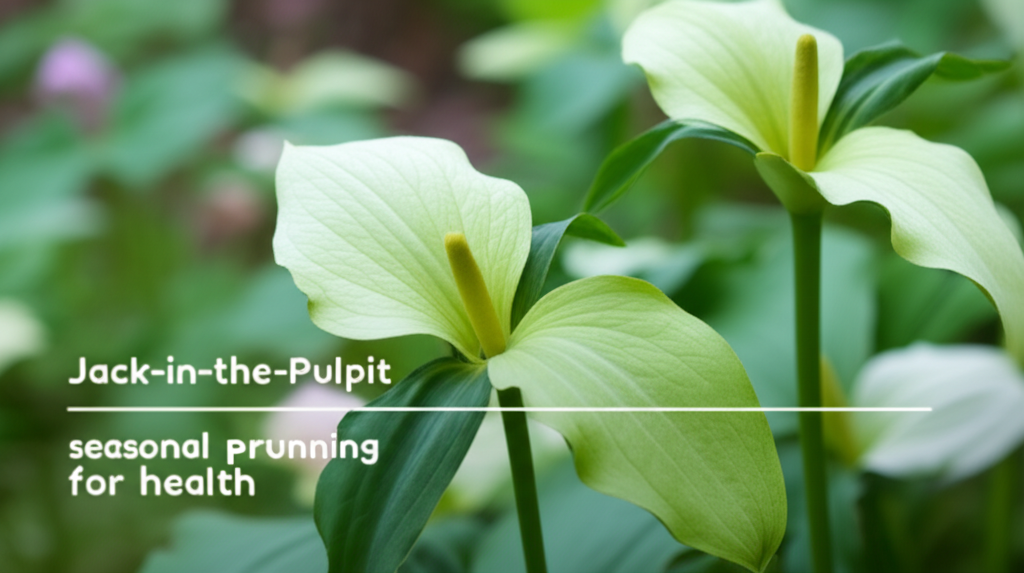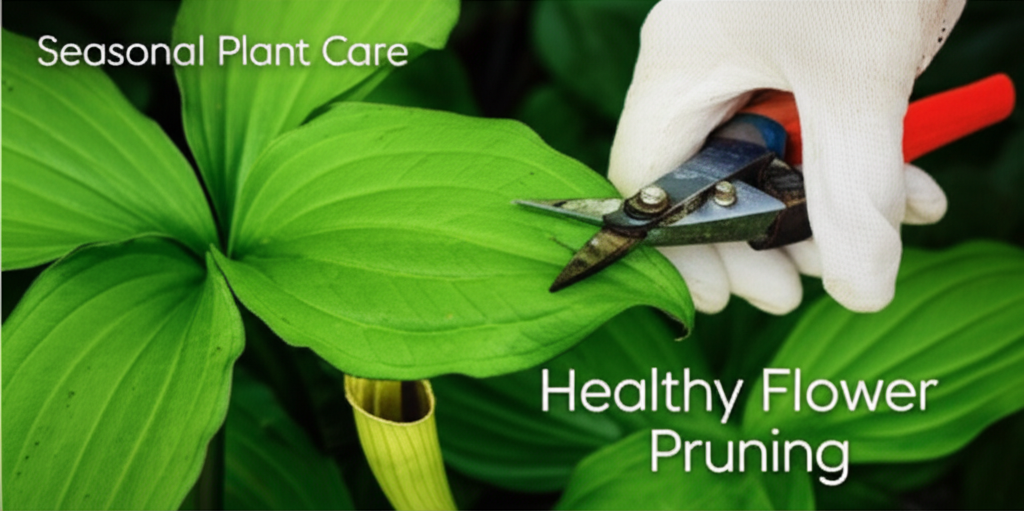Understanding Jack-in-the-Pulpit’s Life Cycle for Optimal Pruning
Jack-in-the-Pulpit (Arisaema triphyllum) is a fascinating woodland native, celebrated for its unique, hooded spathe and spadix. To ensure its health and encourage vigorous flowering, understanding its annual life cycle is paramount. Unlike many common garden plants that require regular deadheading or significant pruning, Jack-in-the-Pulpit’s needs are more nuanced and directly tied to its natural growth and dormancy patterns. Incorrect pruning can inadvertently harm the plant, reducing its energy reserves or even preventing it from flowering in subsequent years. This guide will delve into the best practices for seasonal pruning and care to promote robust growth and abundant blooms.
The Importance of Minimal Intervention
The general philosophy when it comes to Jack-in-the-Pulpit care, including pruning, is one of minimal intervention. These plants have evolved to thrive in the dappled shade and rich, moist soils of deciduous forests, where they naturally shed their foliage and go dormant in response to seasonal changes. Introducing aggressive pruning techniques can disrupt this natural rhythm. The energy for next year’s flowers is stored in the corm during the current growing season, and the foliage plays a crucial role in this energy production. Therefore, any pruning should be strategic and timed to coincide with the plant’s dormancy or at specific points where it benefits the plant’s overall health and reproductive success.
Seasonal Pruning and Care Strategies

Effective Jack-in-the-Pulpit care revolves around observing the plant’s cues and acting accordingly throughout the year.
Spring: The Awakening and Initial Growth
As spring arrives and the soil warms, Jack-in-the-Pulpit emerges from its winter dormancy. You’ll notice the distinctive spathe unfurling, often before the leaves fully expand.
What to do in Spring:
- Observe, Don’t Prune: This is a critical period of emergence and initial growth. Resist the urge to prune anything. The emerging flower stalk and leaves are vital for photosynthesis and energy production.
- Monitor for Pests and Diseases: While not strictly pruning, spring is a good time to check for any signs of slug damage or fungal issues that might affect the developing foliage and flower. Early detection can prevent larger problems.
- Ensure Adequate Moisture: Jack-in-the-Pulpit thrives in consistently moist soil. Ensure the ground is not drying out, especially as temperatures begin to rise.
Summer: Peak Growth and Fruiting
During the summer months, the Jack-in-the-Pulpit reaches its full growth potential. After flowering, the spadix often develops into a cluster of bright red berries, which are a beautiful feature and attract wildlife.
What to do in Summer:
- Allow Foliage to Mature: The leaves continue to photosynthesize throughout the summer, storing energy in the corm for the following year. Do not cut back the foliage, even if it begins to look a bit tired or slightly yellowed towards the end of the season.
- Berry Formation: If your plant has been pollinated, you will see the development of attractive berry clusters. These are a sign of a healthy, well-established plant.
- Weed Control: Keep the area around the Jack-in-the-Pulpit free of competing weeds, which can steal valuable moisture and nutrients. Be careful not to disturb the soil deeply, as this can damage the shallow corm.
Autumn: Natural Decline and Preparation for Dormancy
As the days shorten and temperatures cool, Jack-in-the-Pulpit naturally begins to prepare for dormancy. The foliage will start to yellow, then brown, and eventually wither away.
What to do in Autumn:
- Allow Natural Dieback: This is the most crucial “pruning” phase, but it’s actually allowing the plant to do its natural pruning. Let the foliage die back completely on its own. The remaining plant material will continue to transfer nutrients down to the corm.
- Remove Dead Foliage (Only When Fully Browned): Once the leaves are completely withered and brown, you can gently remove them. This helps to tidy the garden bed and can prevent the buildup of potential fungal spores. However, if there is any green remaining, it is still beneficial for the plant to leave it.
- Top Dressing: After the foliage has died back, consider adding a layer of compost or leaf mold around the base of the plant. This will break down over winter, providing nutrients for the spring growth.
Winter: Dormancy and Rest
The winter months are a period of complete dormancy for Jack-in-the-Pulpit. The plant is entirely underground, with only its corm resting in the soil.
What to do in Winter:
- No Pruning Necessary: At this stage, there is nothing to prune. The plant is safely dormant.
- Protect from Disturbance: Avoid any digging or significant soil disturbance in the area where Jack-in-the-Pulpit is planted. This can damage the dormant corm.
- Mulch (Optional but Beneficial): If you live in a region with harsh winters or where the soil might heave, a light layer of mulch (leaf mold, straw, or pine needles) can provide extra insulation and protection for the corm.
Key Considerations for Jack-in-the-Pulpit Pruning
To reiterate, Jack-in-the-Pulpit pruning is less about cutting and more about understanding and respecting its natural life cycle.
When NOT to Prune
There are several critical times when pruning Jack-in-the-Pulpit is detrimental:
- While the plant is actively growing (Spring/Summer): Cutting back healthy green foliage will rob the plant of the energy it needs to store for future flowering.
- When the foliage is still partially green in Autumn: This indicates the plant is still photosynthesizing and transferring energy to the corm.
- Aggressively removing spent flower stalks: While spent flower stalks can be removed if they are unsightly, it’s best to wait until they have fully yellowed and begun to wither, and even then, gentle removal is preferred. In some cases, leaving the spent stalks can even offer a bit of protection to the developing corm.
When Pruning is Beneficial
The only true “pruning” you’ll typically do for Jack-in-the-Pulpit involves removing material that is clearly dead and has completed its purpose.
- Removing fully dried and withered foliage in late Autumn/early Winter: This is primarily for aesthetic reasons and to clear the garden bed.
- Removing any obviously diseased or damaged leaves during the growing season: This is a rare occurrence and should be done cautiously, only if the disease or damage is severe and likely to spread or weaken the plant significantly.
Jack-in-the-Pulpit Pruning: A Comparison to Other Woodland Natives
Understanding how Jack-in-the-Pulpit’s pruning needs compare to other common woodland plants can further clarify best practices.
| Plant | Pruning Approach | Reasoning | Best Time for Action |
|---|---|---|---|
| Jack-in-the-Pulpit | Minimal intervention; allow natural dieback. Remove only fully dead foliage. | Energy storage in corm relies on full foliage. Disrupting growth cycle hinders future flowering. | Late Autumn/Early Winter (for fully dead foliage). |
| Hostas | Deadhead spent flower stalks; cut back foliage in Autumn after frost. | Encourages reblooming (for some varieties); prevents disease buildup; tidiness. | Summer (deadheading); Late Autumn (foliage). |
| Ferns (e.g., Ostrich Fern) | Remove dead fronds as they appear or in Spring. Some gardeners tie up fronds in Autumn for winter interest and protection. | Aesthetics; prevents rot and disease; winter protection. | As needed (dead fronds); Spring (tidying); Autumn (tying). |
| Bleeding Hearts | Deadhead spent flowers to encourage reblooming. Cut back foliage if it yellows and dies back in mid-summer heat. | Promotes secondary bloom; manages summer dormancy. | Late Spring/Early Summer (deadheading); Mid-Summer (foliage cutback if needed). |
Troubleshooting and Advanced Care
While pruning is minimal, other care practices significantly impact Jack-in-the-Pulpit’s health and flowering potential.
Ensuring Good Bloom Production
Several factors influence whether your Jack-in-the-Pulpit will produce flowers each year. While pruning is not a direct factor, healthy growth fostered by proper care is.
- Light Conditions: Jack-in-the-Pulpit prefers dappled shade. Too much sun can scorch the leaves and stress the plant, while too much shade might reduce flowering. Aim for a location that receives morning sun and afternoon shade, or is consistently shaded by deciduous trees.
- Soil Moisture: Consistently moist, well-drained soil is crucial. Avoid letting the soil dry out completely, especially during the growing season. In dry spells, supplemental watering is necessary.
- Soil Composition: Rich, humusy soil is ideal. Amending your soil with compost or leaf mold annually will provide the necessary nutrients and improve soil structure.
- Plant Age and Maturity: Young plants may take a few years to establish before they are mature enough to flower reliably. Patience is key.
- Pollination: For the plant to produce berries, it needs to be pollinated. Flies are the primary pollinators. Having multiple plants can increase the chances of cross-pollination.
Dealing with Common Issues
Although robust, Jack-in-the-Pulpit can encounter some problems.
- Slugs and Snails: These are the most common pests. Their damage can deface the leaves and flowers. Using slug bait, diatomaceous earth, or creating barriers can help.
- Fungal Diseases: While less common, fungal spots can appear, especially in humid conditions. Ensuring good air circulation and avoiding overhead watering can help prevent this. Remove affected leaves if they are severe.
- Dormancy Issues: Sometimes, a plant might appear to fail to emerge. This is often due to the corm not being strong enough, overly dry soil during dormancy, or excessive disturbance of the soil.
The Role of Pruning in the Jack-in-the-Pulpit Life Cycle
Pruning, in the conventional sense, plays a very minor role in the life cycle of Jack-in-the-Pulpit. The plant’s natural ability to shed its leaves and go dormant is its primary mechanism for energy conservation and survival.
| Stage | Primary Action | Description | Pros | Cons |
|---|---|---|---|---|
| Spring | Observe; Water | Plant emerges; leaves and spathe develop. | Allows for natural growth; Promotes energy uptake. | Vulnerability to early pests (slugs). |
| Summer | Weed Control; Ensure Moisture | Full growth and potential berry production. | Supports photosynthesis and corm development; enhances appearance (berries). | Competition from weeds can weaken the plant. |
| Autumn | Allow Natural Dieback; Remove Fully Browned Foliage | Plant prepares for dormancy; foliage yellows and dies. | Nutrient transfer to corm; tidies garden; prevents potential disease spread (if fully dead). | Premature removal of foliage reduces energy storage. |
| Winter | No Action; Protect from Disturbance | Plant is fully dormant underground. | Allows corm to rest and regenerate energy. | Risk of damage from digging or frost heave if not mulched. |
Encouraging Natural Reproduction
While not direct pruning, understanding the plant’s reproductive cycle is vital for its long-term presence.
- Seed Dispersal: The attractive red berries are a food source for birds, which then help disperse the seeds. If you want to encourage natural spread, leaving the berries intact until birds consume them is ideal.
- New Plants: Jack-in-the-Pulpit can also spread via rhizomes. Avoid disturbing the soil significantly to allow these to develop undisturbed.
Conclusion: The Art of Minimal Care
In essence, successful “pruning” for Jack-in-the-Pulpit is about adopting a philosophy of careful observation and minimal intervention. By understanding its natural life cycle and providing the right environmental conditions, you will foster a healthy, resilient plant that rewards you with its unique beauty year after year. The focus should always be on supporting the plant’s energy storage and natural dormancy, rather than on the cosmetic manipulations often associated with other garden plants. Embrace the wild charm of the Jack-in-the-Pulpit and let nature guide your care.


